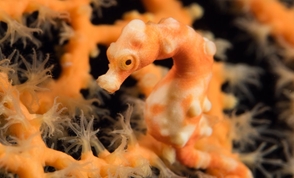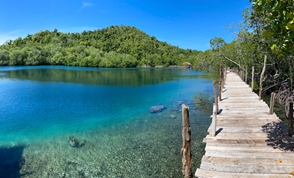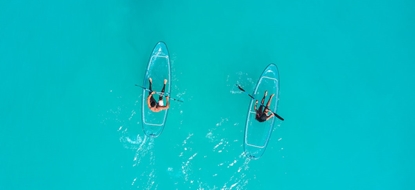10 best places for macro diving
After years of searching for whale sharks and ticking off all the big fish sightings on the bucket list, divers often turn to the smaller weird and wonderful critters to fill their logbooks. Whilst ‘macro’ actually means large scale, the term macro diving came from the lens that photographers use to capture tiny and colourful creatures. Macro diving can be just as exciting as searching for the big stuff when you get your eye in, spotting everything from multi-coloured nudibranchs to octopus and cuttlefish to pygmy seahorses. Local, expert guides are essential in finding the critters that are often extremely well camouflaged. Based on our first-hand experience and my background in marine biology, we have rounded up our 10 best places for macro diving:

Bunaken National Marine Park, Indonesia
North Sulawesi in Indonesia is often thought of as the best macro diving on earth and it is easy to see why. Off the northern tip of the peninsula, Bunaken National Marine Park has a perfect combination of pristine coral reefs and excellent macro life. Whilst drifting along the impressive walls, orangutan crabs can be found on bubble anemones wafting in the current, as well as ghost pipefish, nudibranchs and many species of shrimp. Heading back towards the mainland, the sandy shores near to Manado make the perfect habitat for muck diving. Sandy slopes with a mix of coral play host to many species of frogfish (including painted, giant and clown), flamboyant cuttlefish, ribbon eels and even mimic and wunderpus octopuses.

Lembeh Strait, Indonesia
Heading over to the eastern side of the peninsula, only a couple of hours by road, is the Lembeh Strait: the muck diving capital of the world. If you wanted to tick off as many critters as possible in one trip, then Lembeh would be the place to go. Whilst not as picturesque Bunaken, the black sandy sea floor is teeming with the weird and wonderful. On my first few dives here, it conjured up images of outer space with alien-like creatures hiding in the debris. Macro diving here is at its very best and the list of possible critter sightings is endless. A few standout species include the hairy frogfish, pontohi pygmy seahorse, rhinopias scorpionfish and bluering octopus.

Alor, Indonesia
Staying in Indonesia, which does after all have the highest marine biodiversity on the planet, Alor is home to some of the best macro diving in the world. A diving destination that truly blew us away, Alor has the perfect combination of immaculate coral reef diving, muck diving and even the chance to see big stuff. On the black sand muck sites, divers can encounter a myriad of critters including weedy scorpion fish, candy and pom pom crabs, harlequin and hairy shrimps and coconut octopus to name a few. The house reef of Alami Alor has a mix of black sand and coral, perfect for spotting critters and at sunset, mating mandarinfish. This remote destination should be on every macro diving bucket list.

Tulamben, Indonesia
Off the shores of the east coast of Bali, there is a lot on offer when it comes to macro diving. Black sand slopes are the perfect environment for the weird and wonderful to thrive, punctuated with healthy coral formations. The area has a handful for excellent macro dive sites, including our favourite ‘Secret Seraya’. Across these sites, divers can find bobtail squid (a personal favourite!), bumble bee shrimp, leaffish and an amazing variety of nudibranchs.

Dumaguete, Philippines
Leaving Indonesia but remaining in the Coral Triangle, next up on our list is Dumaguete in the Central Visayas, Philippines. Another hotspot for macro diving, the black sand provides a nutrient-rich environment for a whole host of magnificent macro and is pristine, with very little trash. Many of the sought-after species here are masters of camouflage, so a resident marine biologist such as those based at Atmosphere Resort and Salaya, make all the difference to the experience. Divers can expect to see numerous rare species, not just during the trip but in a single dive, including Ambon scorpionfish, ornate ghost pipefish, halimeda crab and pygmy seahorse to name a few. The added bonus of the macro diving in this region is that divers and snorkellers can also enjoy the incredible coral reef diving around Apo Island, just 20 minutes by boat.

Anda (Bohol), Philippines
A ferry ride away from Dumaguete and also in the Central Visayas, Bohol has a wealth of diving opportunities. However, for macro diving we recommend heading to a quiet corner of the island called Anda. This spot easily makes it into our top macro diving destinations, staying at the wonderful Amun ini Resort. For those that are less interested in ‘mucky sites’, Anda is the place to go with some of the healthiest coral reefs we have seen, home to some of the rarest critters. The expert dive guides will help guests track down these creatures from innumerable nudibranchs to the leopard anemone shrimp to multiple species of octopus including algae, mimic and bluering.

Moalboal, Philippines
Also in the Visayas off the west coast of Cebu, Moalboal is well worth a visit for macro diving. Most famous for the giant school of resident sardines that sits just off the coast, there are plenty of critters to be found when the focus is turned to the coral rubble. Just beneath the jetty of Kasai Village, bobtail squid can be spotted whilst the colourful sea fans at around 25m depth are host to pygmy seahorses. Blackwater diving is also offered in the area, a different type of diving altogether but still focusing on the small stuff.

Anilao, Philippines
Just a two-and-a-half-hour drive from Manila, Anilao is particularly popular with underwater photographers due to the amazing macro diving opportunities. Photographers will be torn between capturing beautiful hard and soft corals or weird and wonderful creatures. The muck diving sites are home to over 600 species of nudibranch, five species of octopus as well as frogfish, shrimps and crab. Night dives are excellent here where a totally different set of critters emerge in the dark.

Milne Bay, Papua New Guinea
Milne Bay is easily one of the best spots on earth for macro diving and specifically ‘Dinah’s Beach’ (or Lauadi), the birthplace of muck diving. Discovered by Bob Halstead’s who named the site after his wife, he managed to convince his diving guests to dive in a spot with no beautiful scenery. Eventually he was successful and thus muck diving was born. A myriad of critters can be seen from numerous nudibranchs to octopus such as the mimic. What makes this spot even more special is the dive site ‘Deacon’s Reef’ that sits just next door. Possibly my favourite coral reef dive of all time, the topography is otherworldly with pristine coral towers standing tall amongst fields of bright red whip coral. Nudibranchs cling on to the reef structures laying skirts of eggs and giant trevally hang in the shade of the overhanging jungle. This dive site duo is hard to beat.

Mafia Island, Tanzania
The only dive destination in this list that does not reside in the Coral Triangle, Mafia Island is a macro diving haven. Diving from the shore with the expert team from Mafia Island Diving provides amazing macro diving, exploring sandy flats, coral bommies and seagrass. On a recent trip to Mafia Island, Reefscape Director India raves about sightings of frogfish, shrimps, crabs and over 100 species of nudibranchs, including the ‘Shaun the sheep’ nudibranch, more commonly seen in Asia. David and Danielle of Mafia Island Diving are macro maniacs, so will be sure to make sure any with the same interests will be blown away by their findings.












